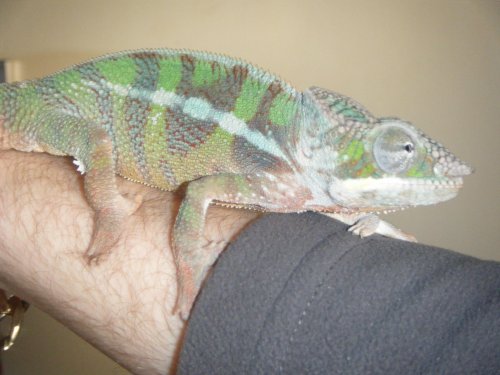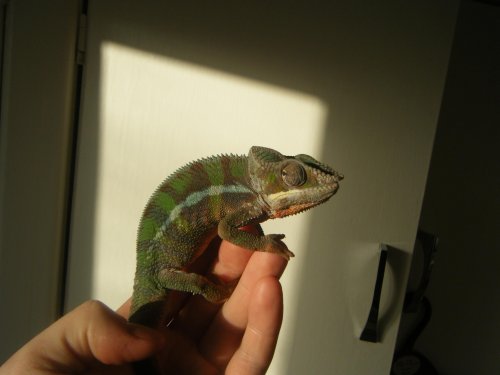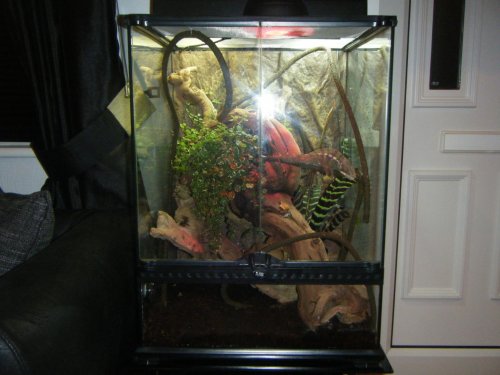Got Godzilla about 2 months ago now. Would like peoples advice on the below setup etc to make sure everything is in order.
1. Ambilobe Panther chameleon, Male around 6 months old, i got him when he was about 3 months.
2. Handle him every day, let him roam around on the sofa and stairs for 5 mins, otherwise he gets angry trying to escape from his tank. He gets fed most of his worms while he is out in my hand.
3. Feed - his main diet is crickets/locust and mealworm/waxworm, about 10 per day. Feed him every morning before i go to work. crickets,locust, waxworms are gut loaded with shop bought bug food and supplemented with fresh fruit, greens etc.
4. Supplement every day with calcium only (calci-dust), every other week with multivitimans (arkvits) and twice a month with nutrobol.
5. Dripper set up into bowl thats emptied, mist with boiled water (to remove chlorine) 2 times per day.
6. Small white bit with large black brown bit. white bit been a bit off white colour recently. I have never tested him for parasites? how do you do that?
7. Tank - he is in an exo-terra glass terrium with mesh top. Dimensions are 45cm x 45cm x 60cm(high)
8. Lighting - lights are switched by timer and are on 7am-7pm. Two lights in hood both exo terra UVB repti glow 2.0 (old just used for extra light and UVB repti glow 5.0. And 1 x 50w red heat bulb sat ontop of mesh (outside cage).
9. Temp - cage floor is about 70degrees, top of tank around 75 degrees, under basking light about 85. All lights are off at night and temp falls to lowest 60degrees.
10. Humidity - humidity levels at 80-85%, . Measured by probe hydrometer.
11. Plants - 2 live plants ficus (unsure what type), and bromeliad
12. placement - cage located next to front door in house, quite high traffic area but he doesnt seem to mind. Top of cage is about 115cm from floor.
13. I live in United Kingdom - Manchester.
He has currently stopped eating crickets and will only eat waxworms/mealworms and locust. Going to give him a week or so off and try re introducing them.


1. Ambilobe Panther chameleon, Male around 6 months old, i got him when he was about 3 months.
2. Handle him every day, let him roam around on the sofa and stairs for 5 mins, otherwise he gets angry trying to escape from his tank. He gets fed most of his worms while he is out in my hand.
3. Feed - his main diet is crickets/locust and mealworm/waxworm, about 10 per day. Feed him every morning before i go to work. crickets,locust, waxworms are gut loaded with shop bought bug food and supplemented with fresh fruit, greens etc.
4. Supplement every day with calcium only (calci-dust), every other week with multivitimans (arkvits) and twice a month with nutrobol.
5. Dripper set up into bowl thats emptied, mist with boiled water (to remove chlorine) 2 times per day.
6. Small white bit with large black brown bit. white bit been a bit off white colour recently. I have never tested him for parasites? how do you do that?
7. Tank - he is in an exo-terra glass terrium with mesh top. Dimensions are 45cm x 45cm x 60cm(high)
8. Lighting - lights are switched by timer and are on 7am-7pm. Two lights in hood both exo terra UVB repti glow 2.0 (old just used for extra light and UVB repti glow 5.0. And 1 x 50w red heat bulb sat ontop of mesh (outside cage).
9. Temp - cage floor is about 70degrees, top of tank around 75 degrees, under basking light about 85. All lights are off at night and temp falls to lowest 60degrees.
10. Humidity - humidity levels at 80-85%, . Measured by probe hydrometer.
11. Plants - 2 live plants ficus (unsure what type), and bromeliad
12. placement - cage located next to front door in house, quite high traffic area but he doesnt seem to mind. Top of cage is about 115cm from floor.
13. I live in United Kingdom - Manchester.
He has currently stopped eating crickets and will only eat waxworms/mealworms and locust. Going to give him a week or so off and try re introducing them.




